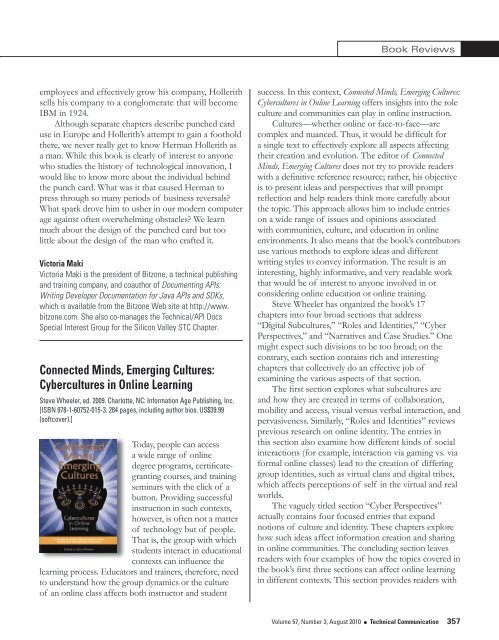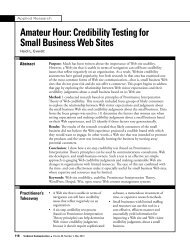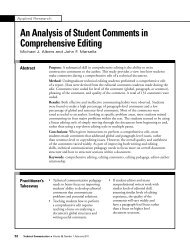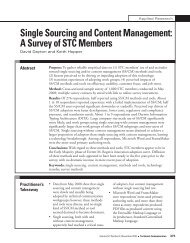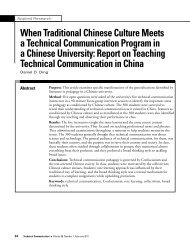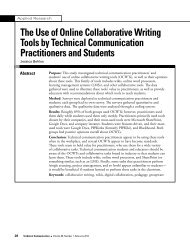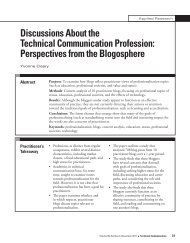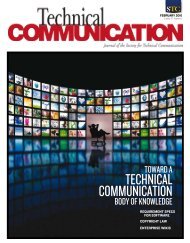Book Reviews“elegant” and “compelling” (pp. 9–10). This approachprovides students and faculty with relatively objective,specific, and actionable criteria for identifyingstrengths and addressing weaknesses.The strong emphasis on writing quality stems fromcomplaints by science and engineering faculty about“the surprising amount of poor writing they see amongtheir graduate students” (p. 22). Though it is obvious totechnical communicators, many science and engineeringstudents do not realize the importance of writing totheir careers; this booklet pointedly reminds them thatonce they are working in their profession, their “writingwill be an indicator of the quality” of their thoughtand their “attention to the details of research.” If they“cannot convey [their] ideas and data clearly, concisely,and coherently, the reader will not be able to appreciatetheir import” (p. 22).By offering practical, directly applicable qualitymetrics for scientific and technical dissertations,including originality and significance, the authorshelp students and faculty clarify mutual expectationsand eliminate the misunderstanding that makesdissertations unnecessarily onerous. The authorsespecially intend that students use their advice tobecome more proactive in consciously managing thecommunication demands of their professions. Theresponsibility, they emphasize, lies more with thestudent than the teacher.Short, inexpensive, practical, offering usableadvice based on Lovitts’ own previously publishedresearch, laid out in distinct modules that are easilyidentified and assigned, and focused on representativedisciplines that are generally applicable, this pamphletcan readily supplement in-depth study of dissertationresearch and writing methods. Recommended.Donald R. RiccominiPunched-Card Systems and the EarlyInformation Explosion, 1880–1945Lars Heide. 2009. Baltimore, MD: The Johns Hopkins University Press.[ISBN 978-0-8018-9143-4. 370 pages, including index. US$65.00.]As a college freshman in1970, I sat down to thetedious task of registering forclasses by filling out a stackof punch cards (#2 pencilonly!), with little awarenessof the rich history containedin those humble pastel cards.Lars Heide tells that story.The book begins withHerman Hollerith’s inventionof a punch system to count the 1890 U.S. census. Welearn of Hollerith’s struggles to develop the punchcard technology and find other customers besidesthe Census Bureau, and his eventual break with theBureau. In 1902, the originally ad hoc Census Bureaubecomes a permanent institution by congressionaldegree. With a new director, Simon Newton DexterNorth, the Bureau is now all about controlling costs.North demands price concessions from Hollerith forthe rental of his punched-card machines and asks forcongressional funds to build his own machines. The riftbetween North and Hollerith results in the loss of thecensus contract in 1905 and Hollerith’s search for othermarkets.We follow Hollerith as he joins forces with EugeneA. Ford, an experienced shop engineer, who helpshim simplify and standardize his machines. He cannow respond to the First World War and the growingdemand for his “tabulating machines.” The need tomobilize and then statistically track men and munitionsis a boon for Hollerith’s company, the TabulatingMachine Company. Each punch card for the war effortcontains a printed “Man Number” that identifies eachsolder and facilitates statistical processing.The use of punched cards to facilitate informationstorage continues into the Second World War. AsHeide puts it, “The punched card was the basis forthe most advanced information technology from the1920s to the Second World War” (p. 5). Along theway, unable to meet demands for his machines andhobbled by an inability to delegate responsibility to356 Technical Communication l Volume 57, Number 3, August 2010
Book Reviewsemployees and effectively grow his company, Hollerithsells his company to a conglomerate that will becomeIBM in 1924.Although separate chapters describe punched carduse in Europe and Hollerith’s attempt to gain a footholdthere, we never really get to know Herman Hollerith asa man. While this book is clearly of interest to anyonewho studies the history of technological innovation, Iwould like to know more about the individual behindthe punch card. What was it that caused Herman topress through so many periods of business reversals?What spark drove him to usher in our modern computerage against often overwhelming obstacles? We learnmuch about the design of the punched card but toolittle about the design of the man who crafted it.Victoria MakiVictoria Maki is the president of Bitzone, a technical publishingand training company, and coauthor of Documenting APIs:Writing Developer Documentation for Java APIs and SDKs,which is available from the Bitzone Web site at http://www.bitzone.com. She also co-manages the Technical/API DocsSpecial Interest Group for the Silicon Valley STC Chapter.Connected Minds, Emerging Cultures:Cybercultures in Online LearningSteve Wheeler, ed. 2009. Charlotte, NC: Information Age Publishing, Inc.[ISBN 978-1-60752-015-3. 284 pages, including author bios. US$39.99(softcover).]Today, people can accessa wide range of onlinedegree programs, certificategrantingcourses, and trainingseminars with the click of abutton. Providing successfulinstruction in such contexts,however, is often not a matterof technology but of people.That is, the group with whichstudents interact in educationalcontexts can influence thelearning process. Educators and trainers, therefore, needto understand how the group dynamics or the cultureof an online class affects both instructor and studentsuccess. In this context, Connected Minds, Emerging Cultures:Cybercultures in Online Learning offers insights into the roleculture and communities can play in online instruction.Cultures—whether online or face-to-face—arecomplex and nuanced. Thus, it would be difficult fora single text to effectively explore all aspects affectingtheir creation and evolution. The editor of ConnectedMinds, Emerging Cultures does not try to provide readerswith a definitive reference resource; rather, his objectiveis to present ideas and perspectives that will promptreflection and help readers think more carefully aboutthe topic. This approach allows him to include entrieson a wide range of issues and opinions associatedwith communities, culture, and education in onlineenvironments. It also means that the book’s contributorsuse various methods to explore ideas and differentwriting styles to convey information. The result is aninteresting, highly informative, and very readable workthat would be of interest to anyone involved in orconsidering online education or online training.Steve Wheeler has organized the book’s 17chapters into four broad sections that address“Digital Subcultures,” “Roles and Identities,” “CyberPerspectives,” and “Narratives and Case Studies.” Onemight expect such divisions to be too broad; on thecontrary, each section contains rich and interestingchapters that collectively do an effective job ofexamining the various aspects of that section.The first section explores what subcultures areand how they are created in terms of collaboration,mobility and access, visual versus verbal interaction, andpervasiveness. Similarly, “Roles and Identities” reviewsprevious research on online identity. The entries inthis section also examine how different kinds of socialinteractions (for example, interaction via gaming vs. viaformal online classes) lead to the creation of differinggroup identities, such as virtual clans and digital tribes,which affects perceptions of self in the virtual and realworlds.The vaguely titled section “Cyber Perspectives”actually contains four focused entries that expandnotions of culture and identity. These chapters explorehow such ideas affect information creation and sharingin online communities. The concluding section leavesreaders with four examples of how the topics covered inthe book’s first three sections can affect online learningin different contexts. This section provides readers withVolume 57, Number 3, August 2010 l Technical Communication 357
- Page 1 and 2:
AUGUST 2010Volume 57 Number 3SPECIA
- Page 3 and 4:
PresidentMichael A. HughesVice Pres
- Page 5 and 6:
VoLuME 57, NuMBER 3AUGUST 2010ISSN
- Page 7 and 8:
Guest EditorialKirk St.Amant and Ma
- Page 9 and 10:
Applied ResearchTechnical Communica
- Page 11 and 12:
Applied ResearchNicole St. Germaine
- Page 13 and 14:
Applied ResearchNicole St. Germaine
- Page 15 and 16:
Applied ResearchNicole St. Germaine
- Page 17 and 18:
Applied ResearchNicole St. Germaine
- Page 19 and 20:
Applied ResearchNicole St. Germaine
- Page 21 and 22:
Applied ResearchNicole St. Germaine
- Page 23 and 24:
Applied ResearchNicole St. Germaine
- Page 25 and 26:
Applied TheoryTatiana BatovaIntrodu
- Page 27 and 28:
Applied TheoryTatiana BatovaMoreno,
- Page 29 and 30:
Applied TheoryTatiana BatovaThe Uni
- Page 31 and 32:
Applied TheoryTatiana Batovadoctors
- Page 33 and 34:
Applied TheoryTatiana BatovaTo addr
- Page 35 and 36:
Applied TheoryTatiana Batovathe loc
- Page 37 and 38:
Applied TheoryTatiana BatovaJohnson
- Page 39 and 40:
Applied TheoryTatiana BatovaInterna
- Page 41 and 42:
Applied TheoryMcKee and PorterIntro
- Page 43 and 44:
Applied TheoryMcKee and PorterFor e
- Page 45 and 46:
Applied TheoryMcKee and Porterpubli
- Page 47 and 48:
Applied TheoryMcKee and PorterBecau
- Page 49 and 50:
Applied TheoryMcKee and Porterof th
- Page 51 and 52:
Applied TheoryMcKee and Porterwith
- Page 53 and 54:
Applied TheoryMcKee and PorterA Cop
- Page 55 and 56:
Applied TheoryMcKee and PorterConte
- Page 57 and 58:
Applied TheoryMcKee and PorterWalto
- Page 59 and 60:
Applied ResearchLiza PottsIntroduct
- Page 61 and 62:
Applied ResearchLiza Pottsdoes not
- Page 63 and 64: Applied ResearchLiza PottsUser’s
- Page 65 and 66: Applied ResearchLiza Pottsactors, t
- Page 67 and 68: Applied ResearchLiza PottsDRM has a
- Page 69 and 70: Applied ResearchLiza Pottsmake bett
- Page 71 and 72: Applied ResearchLiza PottsOne viewe
- Page 73 and 74: Applied ResearchLiza Pottsinvolved
- Page 75 and 76: Applied ResearchLiza PottsHayhoe, G
- Page 77 and 78: Applied ResearchInternational Fair
- Page 79 and 80: Applied ResearchTyAnna K. Herringto
- Page 81 and 82: Applied ResearchTyAnna K. Herringto
- Page 83 and 84: Applied ResearchTyAnna K. Herringto
- Page 85 and 86: Applied ResearchTyAnna K. Herringto
- Page 87 and 88: Applied ResearchTyAnna K. Herringto
- Page 89 and 90: Book ReviewsWriting Successful Scie
- Page 91 and 92: Book ReviewsThe Process: Business P
- Page 93 and 94: Book ReviewsHCI Beyond the GUI: Des
- Page 95 and 96: Book ReviewsOrigins of the Specious
- Page 97 and 98: Book Reviewsgenre, and process, top
- Page 99 and 100: Book ReviewsPart One goes from the
- Page 101 and 102: Book Reviewsrather than writers, an
- Page 103 and 104: Book ReviewsHow to Write Fast Under
- Page 105 and 106: Book Reviewsmanagement system (CMS)
- Page 107 and 108: Book Reviewsnearly strangled when h
- Page 109 and 110: Book Reviewsinteractive TV model)
- Page 111 and 112: Book ReviewsOtherwise, Beech shows
- Page 113: Book Reviewssuch as blog, I found m
- Page 117 and 118: Recent & RelevantSherry Southard, E
- Page 119 and 120: Recent & RelevantRecent & RelevantC
- Page 121 and 122: Recent & RelevantRecent & RelevantE
- Page 123 and 124: Recent & Relevantworking in a langu
- Page 125 and 126: Recent & RelevantWhat’s the big d
- Page 127 and 128: Recent & RelevantScientific Writing
- Page 129 and 130: Recent & Relevantapplicability. Man
- Page 131: Did You Missthe Summit?Don’t miss


